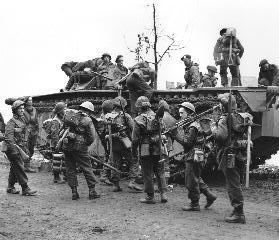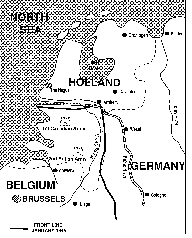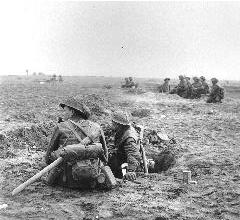
 Midnight, the 1st of January 1945. The Allied armies in Northwest Europe had won a great victory in Normandy and had pursued the German forces to inside the borders of their homeland. Against all expectations, however, the Germans turned on their pursuers at this point and held them at bay along the frontiers as winter descended. Thus, as the fifth year of the war began, the Allied commanders sought a plan to finally destroy the German armies and finally end the war.
Midnight, the 1st of January 1945. The Allied armies in Northwest Europe had won a great victory in Normandy and had pursued the German forces to inside the borders of their homeland. Against all expectations, however, the Germans turned on their pursuers at this point and held them at bay along the frontiers as winter descended. Thus, as the fifth year of the war began, the Allied commanders sought a plan to finally destroy the German armies and finally end the war.
The main German defences in the West were based on two major obstacles - the Siegfried Line and the Rhine River. The Canadian First Army was to play a decisive role in the final offensive by the northern Army Group to clear the west bank of the Rhine before the final thrust on Berlin could begin. In Operation VERITABLE, the Canadian First Army would attack south from Nijmegen, to break through the Siegfried Line and link up with the US Ninth Army which was to advance across the Roer River in the south.

|
| (Photo Credit: National Archives of Canada, PA-145769) |
 |
| (Photo Credit: National Archives of Canada, PA- 177577) |
On February 22, the German First Parachute Army pulled back from the Siegfried Line towards a supporting defensive line called the "Schlieffen Position," leaving an advanced zone of resistance. II Canadian Corps attacked this zone in the early hours of 26 February, with the 3rd Division attacking on the right of the Corps' front. Intense fighting took place to capture the farm villages of Hollen, Keppeln, and Mooshoff, all of which had been turned into strongpoints. For his actions in the capture of this last village, Sgt Aubrey Cousens of the Queen's Own Rifles was posthumously awarded the Victoria Cross.
By March 1, the advance zone of resistance was cleared and the 3rd Division began its role in the attack on the main defensive line, called the "Hochwald Layback" by the Canadians. While the other formations of the II Canadian Corps closed in on the anchor of the German defences at Xanten, the 3rd Division cleared the south portions of the Balberger Wald and Tuschen Wald.
The Allied offensive to clear the west bank of the Rhine was completed on March 11. It was estimated that the Germans had lost 90,000 men in this action, while the Allied forces had sustained 23,000 casualties, of which almost 4,000 were Canadian.
During this period, Canadian soldiers of the 3rd Division were awarded 77 gallantry awards for courage in battle.